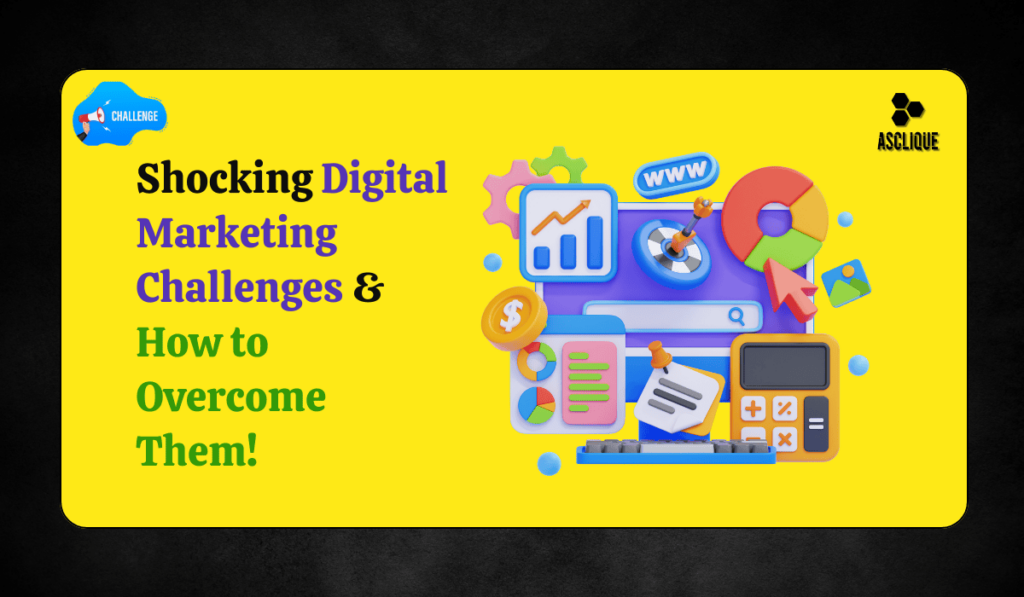The evolution of digital marketing has changed the way companies interact and engage their prospective clientele. Digital marketing, however, while offering immense opportunities, presents its own unique challenges as well. Whether you’re a startup or an established brand, companies now face challenges such as growing competition, algorithm adjustments, data privacy regulations, and shifting consumer behavior. To succeed in such a competitive landscape, businesses must understand these pressing challenges, implement adaptive strategies, and utilize technology to optimize their marketing efforts. In this comprehensive article, we’ll be delving into the top digital marketing business system challenges and concerns and sharing strategies to help businesses streamline their strategies for the best results.
Adapting to New Technologies & Digital Tools
Due to the expansion of AI, automation, and analytics tools, businesses are required to repeatedly update their digital marketing plans to remain relevant. For marketers, new SEO, email marketing, and social media automation tools come to the market every two weeks.
Challenges:
- New marketing tools that you have to scale a steep learning curve on.
- Difficulty in integration of other digital platforms.
- Lack of high quality data for training purposes.
Solutions:
- Provide training to marketing teams to keep them regularly updated about the latest technologies.
- Through tools, such as Hubspot, Marketo, and Semrush, get marketing automation software.
- Invest small with AI-powered tools before doubling down on investments
Example:
Recommendations: Netflix employs AI-powered recommendation engines that personalize content suggestions, enhancing user engagement and retention.
Overwhelming Data and Analytics Interpretation
From website traffic reports to customer interactions and social media engagement metrics, digital marketing generates a plethora of data. But many companies struggle to understand this information and transform it into actionable recommendations. But without effectively interpreting this data, marketing campaigns will rely on conjecture, rather than authentic consumer behavior, which results in failed initiatives and wasted resources.
Challenges:
- Trouble specifying relevant key performance indicators (KPIs).
- Insufficient knowledge in analyzing and interpreting data.
- Too much focus on superficial metrics such as likes and shares.
Solutions:
- Concentrate on metrics that matter like Customer Lifetime Value (CLV) and conversion rates.
- Leverage AI-driven analytics tools such as Google Analytics 4, Power BI, and Tableau.
- Keep a close eye on data reports to modify marketing strategies.
Example:
The ability to tailor product recommendations, products Amazon sells — based on analyzing millions of customers buying behavior is an example of Big data.
The Rise of Voice Search & Its SEO Implications

As users are increasingly using voice search via smart assistants such as Alexa, Google Assistant, and Siri, how people are searching for information has been transformed. To adapt to this change, companies must tailor their SEO strategies.
Challenges:
- Voice search ignores many of the traditional SEO strategies.
- Challenge to rank for long-tail conversational keywords.
- Instability dealing with voice search ROI
Solutions:
- Use natural language queries and long-tail keywords to optimize website content.
- Well-structured data markup can help search engines understand your content better.
- Optimizing for local SEO, as a lot of voice searches are based around location.
Example:
Domino’s Pizza launched voice-activated ordering, resulting in an increase in mobile-based sales.
Balancing Organic and Paid Marketing Efforts
Numerous corporations face the challenge of balancing the two. SEO and content marketing are organic and provide long-term value but take time. Paid marketing techniques, like Google Ads and influencer partnerships, may yield immediate results, however, they can be expensive. Focusing too heavily on a singular strategy can hinder growth — and ROI — as a result. A balanced approach helps achieve the greatest reach, engagement, and success in the long run.
Challenges:
- Paid ads give you immediate visibility, while SEO takes time to yield results.
- The only potential run for digital ads is the high cost of, especially in competitive industries.
- Danger of over-relying on paid traffic without cultivating organic traffic.
Solutions:
- Concentrate on a mixture – pay for quick traffic, build organic reach.
- There are excellent long-term content marketing activities you can invest in, such as starting a blog or recording YouTube videos.
- Experiment with ad types: display, search, video, retargeting, etc.
Example:
A niche ecommerce site optimized for organic content generating 40% less paid spend as traffic still increased.
Customer Retention vs. Customer Acquisition
Many business owners are focused on getting new customers, believing that is the key to growing their business. However, neglecting existing customers can lead to high churn rates and revenue loss. It is even less expensive than acquiring a new customer, as well longer-term benefits. Repeat purchases and referrals to the brand are often made by loyal customers. You are provided with data until October 2023.
Challenges:
- High customer acquisition cost compared to loyal customers.
- Neglecting customers by not having relevant engagement plans.
- Neglecting customer feedback and enhancements in experience.
Solutions:
- When customers return, use loyalty programs that reward them.
- Promote personalized email marketing campaigns to remain engaged.
- Make use of social proof, customer testimonials, and case studies to establish credibility.
Example:
Starbucks upsold members through its Rewards Program by incentivizing customers through discounts & providing personalized offers based on customers’ previous purchases.
The Challenge of Personalization in Marketing
Consumers are expecting personalized content and product recommendations, which can be hard to deliver at scale. Data management, automation, and real-time customization are also challenges for businesses. However, without the appropriate technology and strategy, personalization initiatives can miss the mark. To meet these expectations and promote engagement, you need to leverage AI and customer insights.
Challenges:
- It is challenging to collate and analyze user behavior data.
- Privacy accountability around data usage.
- A new expensive AI-driven personalization technology.
Solutions:
- Leverage behavioral segmentation to personalize marketing efforts.
- Tools such as Mailchimp and ActiveCampaign can help automate email marketing.
- For an improved user experience, implement AI-based chatbots.
Example:
For instance, Spotify leverages AI to create a personalized “Discover Weekly” playlist that suggests new songs and keeps users coming back.
Overcoming Digital Marketing Fatigue
Businesses have an increasingly tough job of capturing consumer attention amidst a crowded advertising, email and content environment. This ad fatigue leads to less engagement and lower conversion rates. Sentences that repeat information or are contradictory can drive visitors away, rather than lead them to a purchase. With your competition widely branching out online, it is essential for brands to adapt to quality, personalized, and value-driven content that forms a real connection with the audience.
Challenges:
- Decreasing email open rates and click-through rates (CTR).
- Increased use of ad blockers.
- Consumers who have shorter attention spans.
Solutions:
- Create content that provides high-quality and valuable information or when appropriate, education as opposed to traditional sales messaging.
- Make use of interactive content like polls, quizzes, and gamification.
- Augmented and virtual reality-based marketing is in its nascent stages.
Example:
Brands began using AR marketing to create interactive consumer engagement campaigns.
Building a Scalable Digital Marketing System
As companies grow, their marketing operations grow, requiring scalable solutions that can accommodate heightened demand. A hard or obsolete marketing framework can lead to growth limitations, inefficiencies, and bottlenecks. Automate as part of your digital marketing system to scale your business Without a solid plan, businesses could find it difficult to keep things consistent, handle multiple channels, and get the best results.
Challenges:
- Unable to manage multiple marketing channels.
- Less automation causing inefficiency
- High costs of hiring an in-house marketing team.
Solutions:
- For the management of campaigns, use customer relationship management (CRM) tools such as Salesforce.
- Use an AI-powered marketing software to automate mundane tasks.
- Use digital marketing outsourcing services for specific needs.
Example:
Zapier taught a startup to automate workflows, slashing their marketing workload by 50%.
Understanding Consumer Behavior & Market Trends
It becomes hard for businesses to predict trends in the market in order to match their marketing strategies according to the latest trends. Preferences change, and economic conditions change, and technology changes the way people interact with brands. A lack of appreciation of the importance of audience behavior can result in businesses creating irrelevant campaigns leading to low rates of engagement and conversion.
Challenges:
- In the last couple of years, there has been a very fast change on what people use social media for and what content they would like to consume.
- Increased online shopping behavior.
- Challenges in reaching Gen Z and younger generations.
Solutions:
- Regular customer surveys will help scope their preferences.
- Consider using a social listening tool like Brandwatch to track trends.
- Analytics-based personas for segmentation of customers
Example:
Nike’s “You Can’t Stop Us” campaign resonated with Gen Z through its promotion of social issues, resulting in higher brand loyalty.
Conclusion
The digital marketing in business is a complex system and requires continuous adaptation to address challenges. The consumer journey is rife with ambivalence, uncertainty, quick decisions, and engagement challenges, with businesses needing to stay ahead of the curve with plans of strengthening algorithms, meeting new data privacy laws, and maximizing marketing effectiveness and customer discernment.
Businesses can now face challenges and adopt sustainable growth by leveraging technology, process automation, data-based decision making and customer-centric approaches.
FAQs
Why is customer retention important in digital marketing?
Customer retention is crucial because it costs less than acquiring new customers. Loyal customers make repeat purchases, refer others, and contribute to long-term business growth.
How can businesses overcome digital marketing fatigue?
To combat digital marketing fatigue, businesses should focus on personalized, high-quality content. Using targeted messaging and reducing excessive ads can help improve engagement.
What is the best way to balance organic and paid marketing?
A balanced strategy involves using SEO and content marketing for long-term growth while leveraging paid ads for immediate visibility and targeted promotions.
How can businesses effectively analyze marketing data?
Businesses should use AI-powered analytics tools, focus on key performance indicators (KPIs), and integrate data from multiple platforms for better insights and decision-making.
What are the key challenges in scaling a digital marketing system?
Challenges include integrating new tools, managing large amounts of data, maintaining consistency across channels, and ensuring high-quality content at scale.

